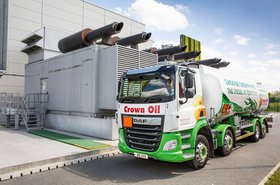Battery storage systems, hydrogen, carbon capture and storage, underwater data centers, even small modular nuclear reactors. Barely a week goes by without the announcement of an esoteric new project intended to make data centers more sustainable.
Yet there’s probably more carbon expended on such laudable initiatives than have so far been saved by them. Not only do they each have flaws; even if they didn’t, almost all remain years or decades away from potential adoption.
But data center operators require solutions now, if not to completely decarbonize (which is currently an unrealizable aim) then to take the next steps on the journey towards decarbonization in affordable, achievable and effective ways. After all, data centers and other critical facilities typically have years of investment sunk into their existing infrastructure that can’t be written off overnight.
One of the most intractable challenges today is backup power – the infrastructure that data centers, in particular, need in order to keep going when grid power goes down. And, although natural gas provides an increasingly popular alternative – especially for building highly resilient microgrids – diesel engines remain the backbone of backup around the world and will do for some time to come.
Low lift sustainability
In the absence of an unambiguously clear alternative to diesel, there are a number of options that organizations can consider to improve the sustainability of their diesel engines and backup infrastructure, says Pritchard, as part of their journey towards Net Zero.
“AVK is involved in all kinds of power projects these days, across Europe and into the Middle East, and especially in the data center sector: everything from diesel backup, upgrades to existing installations, to sustainable on-site microgrids. But what unites them all is the strong desire of the clients to become more sustainable as they take each step on the path to decarbonization,” says Ben Pritchard, the newly promoted CEO of AVK.
Retro-fitting diesel engines with filters and selective catalytic reduction (SCR) is one of those steps. Diesel particulate filters (DPF) were first introduced in the mid-2000s, while SCR followed shortly after. Therefore, many diesel backup engines running today lacked such emissions reductions technologies when they were installed ten or more years ago.
However, retro-fitting emissions control isn’t necessarily a slam-dunk benefit, and operators need to have a clear appreciation of their advantages and disadvantages – in particular, how they actually use their diesel engines – before embarking on such projects.
For example, DPFs require a diesel engine to be regularly run for an extended period of time in order to burn-off the particulates. Failure to do so will clog the filter and, in time, prevent the engine from running. Likewise, says Pritchard, SCR requires the engine to reach a certain temperature before it becomes fully effective.
SCR filters exhaust gases through an ammonia solution to convert much of the nitrous oxide (NOx) emissions into a combination of water and nitrogen, but does it really work well on backup generators?
“SCR is quite interesting, but on standby products, the SCR isn’t necessarily engaged because the engines have to be at temperature,” says Pritchard. “SCRs definitely help [reduce emissions] when you’re going to run for a longer period of time. But they take around 20 minutes to get up to full temperature and, therefore, optimum efficiency. If you look at the average outage across, say, the UK they’re not more than a couple of hours, unless the facility has undergone a catastrophic failure.”
“I don't think everyone should be just putting SCRs on everything. It needs to be done in the right manner. If it's purely for standby reasons, there has to be considerations around how the data center will operate, and consultation with the EA and other authorities, as you may be better upgrading to a cleaner engine,” he adds.
Diesel dilemmas
Diesel backup for data centers, therefore, is a real sustainability and environmental challenge, especially with environmental regulators now appraising data center campuses on their total emissions, as they have grown, and not just the emissions of each data center building.
After all, diesel backup engines need to be regularly tested to ensure that they’re always ready to go within a minute or two. Moreover, diesel fuel doesn’t ‘keep’. Even stored in optimum conditions it can start to degrade within months and, therefore, affect performance and the longevity of engines.
For example, a biodiesel blend stored at around 25 degrees Celsius will be degraded within six months, with bacteria and fungi feeding off the fuel and leaving behind acids and other materials in return. This degradation cannot be reversed and attempting to run an engine on such a murky mix is asking for (very expensive) trouble.
Yet, data center operators running diesel backup engines need tanks of fuel sufficient to keep the facility going for several days, at the very least.
But, while diesel engines may only be needed in an emergency, making sure that they are primed and ready to go when an emergency strikes means that they nevertheless have to be run for significant periods on a regular basis, wasting diesel and raising emissions.
“I don’t think diesel engines are being phased out. Especially in the data center market, the requirement is so strong that it will always need some form of standby or prime power. That said, the industry does need to look at how it is deployed,” says Pritchard.
But while diesel backup isn’t going away any time soon, there are ways they can be run in a carbon-neutral manner.
Go HVO!
At the very top of Pritchard’s prescription list is switching diesel engines to hydro-treated vegetable oil (HVO), upgrading the engines accordingly, if the existing engines are unable to do so. Some engines may not be signed off to run on HVO however it is becoming more and more prevalent in the day to day designs.
HVO is made from feedstock and cooking oil and are therefore, a sustainable and a plant-based alternative to diesel. Unlike traditional biofuels and diesel itself, it doesn’t suffer from performance issues in cold weather, nor is it hygroscopic, attracting moisture from the air that encourages the growth of bacteria, causing the fuel to degrade over time.
While biofuels can start to degrade within months, and diesel within a year, HVO can be stored for up to a decade, and has a higher flashpoint, too. And, it is fully certified by the International Sustainability Carbon Certification (ISCC) and meets the international fuel standard EN15940.
Moreover, the current global food price inflation has thrown the spotlight on traditional biofuels, questioning the wisdom of growing crops purely to make oils to blend with fossil fuels when people need affordable food. HVO puts to good use a waste material that would otherwise be thrown away.
But it is the ease with which HVO can be integrated into an existing diesel set up that makes it the ultimate in low-lift sustainability, says Pritchard. Should a company have half a tank full of diesel, for example, HVO can simply be added into the mix, without affecting performance. This also means that if a site has an existing supply of stored diesel, this can still be used and needn’t go to waste – sustainability can’t get any more ‘low lift’ than that. As a result, 90 percent of the diesel generators AVK sells and installs are now running on HVO.
The one downside, however, is that HVO is between ten to 15 percent more expensive than regular diesel, but AVK’s buying power means that supply ought not be a challenge. “The weight of assets within the fleet in terms of installed generation means we’ve also got pretty good buying power when it comes to HVO. So we can offer bunkering contracts to provide peace of mind after you’ve switched to HVO,” says Pritchard.
Of course, in time, HVO might give way to fuel cells, or ‘green’ hydrogen, but Pritchard doesn’t foresee any practical technological shifts occurring within at least the next five years.
Microgrid movement
However, some data center operators and other major power users are shifting towards on-site generation and microgrids to build-in both sustainability and resilience to their power supplies, says Pritchard, especially in areas where there can be a long wait for a grid connection.
That, says Pritchard, entails a shift towards gas or biomass for primary power on-site, but can also enable the data center operator to be more imaginative when it comes to the power that drives their data center.
“Regardless of whether we’re installing diesel [for backup] or gas engines [for primary power], they are absolutely best-of-breed and are either the most efficient or have the lowest NOx emissions in their class.
“But, in reality, it’s about how you deploy the products. That’s where we sit uniquely because we don’t build any products ourselves. We are a specialist designer and system integrator, and can therefore be a bit more creative with different power technologies,” says Pritchard.
With on-site gas power or duel-fuel generation provided as part of a resilient microgrid, a data center operator can use that as the backbone, but switch to grid power when the wind is blowing or the sun is shining to ensure the lower possible carbon emissions. If, meanwhile, the grid operator is relying on coal or lignite to get them through a dull spell, it’s possible to run the facility on more environmentally friendly on-site gas.
While gas, of course, generates carbon as a bi-product, generating power using gas on-site is more efficient than, say, via the grid, with its inevitable losses between power station and consumer, or even battery storage, which is an inefficient means of power storage. “You’re now in control of your facility’s carbon usage,” says Pritchard.
After all, not every data center can be located in northern Sweden or Norway with their abundant hydropower and the kind of all-year round climate conducive to natural data center cooling.
Already, says Pritchard, AVK has been involved in more than 250MW of gas generation capacity, either completed or going through the design and build stage. “That ranges in sites from around five megawatts, where the client can’t even get a grid connection, all the way up to 100MW or so,” says Pritchard.
Indeed, there are an increasing number of cases where the client has been waiting for years for a grid connection, leaving them with little choice but to explore workable and efficient alternatives.
“If we can bring the power plant to a site where the client has been waiting for, say, four years, we can either own and operate the site for them, and provide energy to the data center under a PPA [power purchase agreement]; or, the data center can own and operate it.
“That enables organizations to get their site up-and-running more quickly – much more quickly in some cases – without having to sweat on when it will be connected to the grid,” says Pritchard.
But that’s not all. “When the grid is finally connected, you can really start to do some clever things in terms of trading your assets. For example, you can trade in terms of carbon rather than strictly on price, and significantly reduce your carbon usage over the years by doing so,” says Pritchard. It’s also possible to install battery storage on-site and charge up when there is a glut of renewable power available.
In other words, a microgrid with local on-site generation enables the data center to be both more sustainable and more resilient, and AVK has recently acquired controls company ECS in order to beef-up its microgrids offerings for clients.
But AVK isn’t religious on the subject.
“We go in completely agnostic. The client tells us, say, that it needs 50MW of power, but doesn’t know when it will get a grid connection. This isn’t unusual anywhere across Europe. We then work out what solutions fit their circumstances best, then provide multiple designs and work out with the client which one works best.
“We can do multiple vendors, multiple technologies and will also take into account, of course, what they want to achieve in the future,” says Pritchard.
On top of that, AVK is also increasingly working with data centers on district heating schemes, building-in heat recovery systems or, in some cases, retrofitting. “The design is straightforward enough – it’s tried and tested. But it’s often a case of trying to find a collaborative party that will have a use for the heat,” admits Pritchard.
Power to the people
This kind of approach requires smart, open-minded people with plenty of industry experience. And, while the data center sector has been subject to rapid change, AVK has adapted accordingly. Staff are multi-skilled, and flexible enough to be able to turn their hand to any number of technical tasks, says Pritchard.
“It's been a pretty big journey for AVK over the past two years. We've employed 40 to 50 new people in new roles; people from different areas who can bring their experience to the data center and other industries. That brings a wealth of knowledge from other businesses or other sectors that may be a bit more advanced on the sustainability side, which is a massive help,” says Pritchard.
And experience is valued; the company hasn’t made the perennial mistake of focusing on younger talent, but has worked hard to keep the knowledge and know-how of people who have 15, 20 or more years in the sector on-board. This includes a number of employees with backgrounds in designing power plants all over the world, working alongside apprentices and graduates to ensure their knowledge is passed on.
“From inception, therefore, we prefer to be involved from day one because we can really impart our knowledge. Most of the successful schemes we’ve been involved in are the ones where we’ve worked collaboratively with clients from the start and seen the project all the way through to completion,” says Pritchard.
To learn more about the breadth of power and backup options your organization should be considering go to AVK’s specialist website.
More from AVK
-

New appointments for AVK accelerate European expansion
New appointments for AVK see the family-run business go from strength to strength
-

Sponsored Powering the future
Introducing innovative solutions for meeting the energy demands of data centers across Europe
-

Plant-powered generators: switching data centers from diesel to HVO
Can backup generators switch to vegetable-based oil, and go green without compromising operations?


